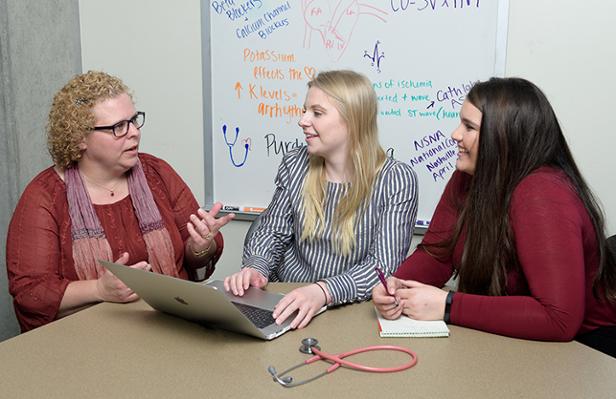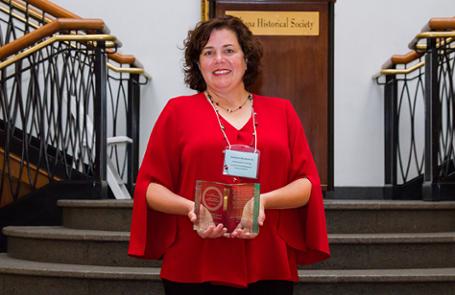Involvement in student associations sets up Purdue nursing grads for success
Written by Becky Brown
In an undergraduate nursing program as rigorous as Purdue's, finding time to focus on non-clinical skills — leadership, communication, organization and time management — can be a challenge. But students who take advantage of the development opportunities provided by organizations such as the National Student Nurses' Association (NSNA) say the payback is well worth the commitment.
"At first, I didn't know if I would have time for all this," says Elizabeth Egan (BSN '19), a West Lafayette native who got involved in several student associations during her first year in the School of Nursing. "But the experience has lived up to expectations. I'm more confident in my ability to communicate and present myself in a professional manner."
Members emerge as leaders and role models
Those attributes are essential in today's health care environment, according to Carmen Jones, a clinical assistant professor of nursing who serves as an advisor for the Purdue Student Nurses' Association (PSNA) and a faculty mentor for the Indiana Association of Nursing Students (IANS). Both are chapters of NSNA.
"Nurses make up the largest number of health care providers in the U.S., and research shows they are the most trusted," Jones says. "Nurses can really make an impact in changing the direction of our health care system and improving patient outcomes, but they need leadership, networking and communication skills to do so."
Indianapolis native Samantha Walesky (BSN '19) serves as vice president of PSNA and was elected president of IANS at the annual state convention in January 2018. She believes the experience she's gaining through these leadership positions will make her not just more effective in the workplace, but also more attractive in the job market.
"I'm able to see the different ways people lead, adapt what they do well and make it my own," she says. "Outside of school, that's going to be a huge thing to market. It will help me be a leader and a role model on the nursing floor."
Egan, the newly elected vice president of IANS, agrees that involvement in student associations helps set Purdue nursing graduates apart.
"A Purdue nursing degree has a great reputation, but we're going to be similar to RNs from other schools when we graduate," she says. "We all pass the same exams, so what makes us different? Purdue puts a lot of value on students getting leadership experience as undergraduates. They provide us with opportunities to stand out."
University, faculty and financial support makes the difference
In the spring of 2016, four students attended NSNA's annual national convention in Orlando. They spent much of the next year sharing what they learned and developing new training, service and mentorship programs for the School of Nursing.
Shortly thereafter, undergraduate nursing students — recognizing the value of participating in national, state and local organizations — voted to become a total enrollment school and increase the annual student fee to include dues for NSNA. In the fall of 2017, the rest of the student body voted unanimously to join the organization.
"Our PSNA president at the time felt that Purdue wasn't represented as much as we could be," Walesky says. "We didn't have a voice at the national level in making decisions. Now we can be a part of those conversations."
Walesky and Egan wasted no time getting involved nationally. In November 2017, the School of Nursing sponsored their attendance at NSNA's annual midyear career planning conference in San Diego. Jones and another faculty advisor, Kit Schafer, also attended.
Egan, who serves as newsletter editor for IANS, came away with new ideas for content and distribution after networking with students from Hawaii, Michigan and Minnesota. Walesky brought back suggestions on how to increase membership and involvement both locally and statewide. And Jones found the mix of student-faculty engagement ideal.
"While students were engaged in sessions related to their current roles and future practices, we spent time in faculty advisor training sessions, learning how best to guide students through these organizations," she says. "We spent time together as well, which helped us get to know our students outside the classroom."
To attend the NSNA midyear conference, Egan and Walesky each received scholarships from the School of Nursing that covered their registration, transportation and hotel costs.
"As a college student, I wouldn't be able to take advantage of these opportunities financially," Walesky says. "Purdue goes above and beyond for us. They encourage us to grow and to research what we can do to improve our student organizations."
A record 42 undergraduate nursing students received scholarship support to attend the recent IANS state convention.
"This is the largest number of nursing students from Purdue ever to participate at IANS," says Jane Kirkpatrick, former head of the School of Nursing and professor emerita. "The engagement of our students provides opportunities to learn how the profession creates change and encourages them to use their voices in self-governance. The support of our alumni and friends makes these pivotal experiences possible." As far as Jones can tell, that support is a big differentiator for the School of Nursing.
"When we were in San Diego, I felt like Purdue was in many ways ahead of the game due to the support we receive," she says. "Other schools didn't have students attending because their professors wouldn't release them from classes. We are so fortunate that our leadership and faculty recognize the importance of student organizations."



